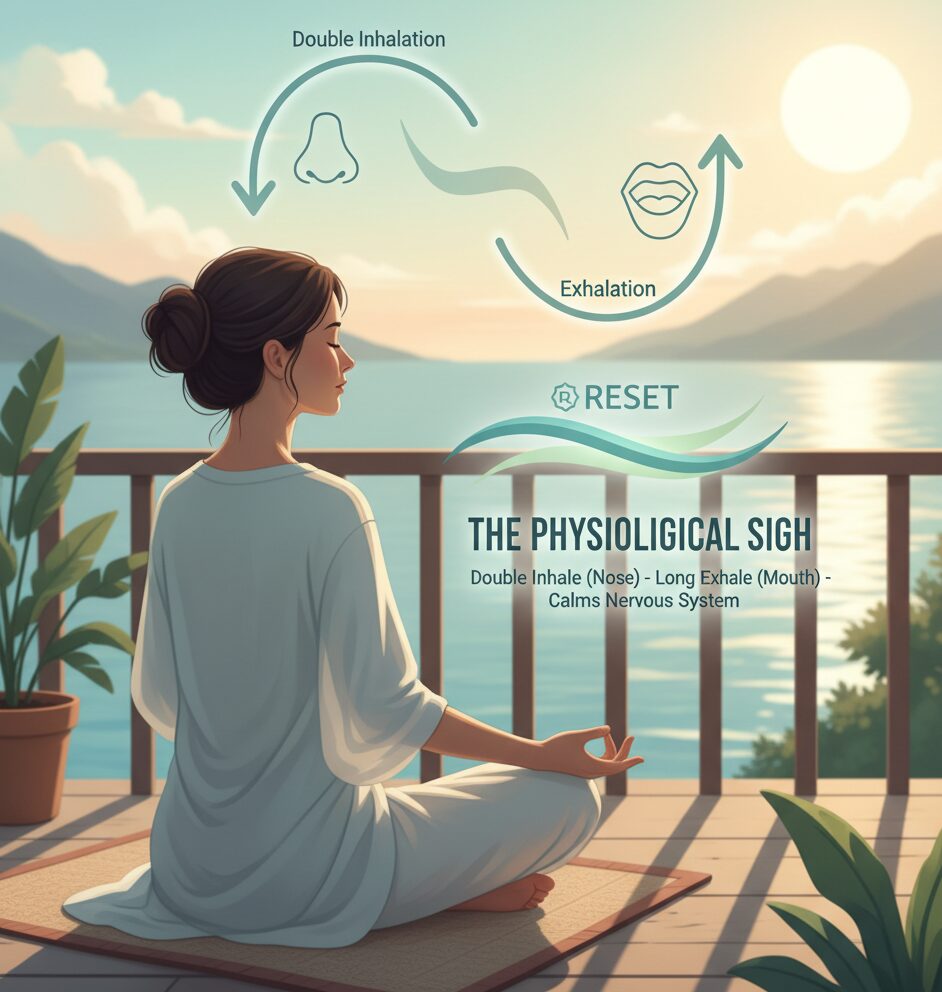The Physiological Sigh
A simple, science-backed breathing technique to rapidly reduce stress and anxiety in real-time.
What is It?
The Physiological Sigh is a specific breathing pattern characterized by a double inhalation through the nose, followed by a long, extended exhalation through the mouth. It's an involuntary reflex our bodies use to reset the nervous system, which can also be performed consciously to rapidly alleviate feelings of stress and anxiety.

Core Principles
- → Bottom-Up Control: It uses the body to control the mind. By changing your breathing pattern, you directly influence your physiological state, which in turn calms your mind.
- → Nervous System Regulation: The primary goal is to shift the autonomic nervous system from a state of high alert (sympathetic, "fight-or-flight") to a state of calm (parasympathetic, "rest-and-digest").
How Does It Work?
The magic is in the mechanics. The double inhale pops open tiny air sacs in the lungs (alveoli) that may have collapsed during shallow, stressed breathing. This maximizes the surface area of the lungs, allowing you to offload carbon dioxide (CO2) more efficiently on the extended exhale. This process signals the brain to slow the heart rate and activate the calming parasympathetic nervous system via the vagus nerve.
How to Practice the Sigh
Double Inhale
Take a deep inhale through your nose. Before exhaling, take another short, sharp inhale to fully inflate your lungs.
Long Exhale
Slowly exhale all the air from your lungs through your mouth. Make the exhale significantly longer than the inhales.
Repeat as Needed
Just 1 to 3 cycles are often enough to feel an immediate sense of calm. Practice throughout the day.
Role of a BSP
A Behaviour Support Practitioner (BSP) can be instrumental in teaching this strategy to a person with a disability. They can:
- Model the technique in a calm and reassuring manner.
- Use visual aids like diagrams or videos to explain the steps.
- Practice the sigh together during calm moments to build muscle memory.
- Help identify personal triggers for stress and prompt the use of the sigh as a proactive coping strategy.
In a Behaviour Support Plan
To integrate the Physiological Sigh into a BSP:
- Identify Antecedents: Clearly define the triggers (e.g., loud noises, transitions) that lead to stress or anxiety.
- Define the Behaviour: Describe the physiological sigh as the replacement coping skill.
- Teaching Strategy: Detail the teaching methods (modeling, visual cards, prompting) and the schedule for practice.
- Reinforcement: Outline how the use of the strategy will be positively reinforced (e.g., praise, a preferred activity).
When and Where to Use It
This strategy is highly adaptable and can be used in various conditions:
- Moments of anxiety or panic.
- When feeling frustrated or angry.
- During periods of sensory overload.
- Before or during challenging transitions or new situations.
- To calm down after a startling event.
- In any public or private setting, as it's discreet and quiet.
Real-Life Scenario
Meet Alex: Alex is a young adult with autism who finds crowded spaces like shopping centres overwhelming. The bright lights, loud announcements, and proximity to strangers often trigger significant anxiety, leading to a desire to flee the situation.
The Implementation:
- Preparation: Alex's BSP, Sarah, practiced the physiological sigh with him at home using a visual cue card. They practiced daily when Alex was calm, associating the breathing with a feeling of relaxation.
- In the Moment: During a trip to the shops, Alex starts to feel overwhelmed. He shows his agreed-upon sign for stress (tapping his wrist).
- The Prompt: Sarah calmly and quietly gets Alex's attention and taps her own wrist, then points to the visual cue card for the sigh which she carries.
- The Action: Together, they step to the side of the walkway. Sarah models the double inhale and long exhale. Alex mirrors her. They repeat it twice.
- The Outcome: The physiological sighs help to lower Alex's immediate physiological arousal. His heart rate slows, and he feels more grounded. This brief reset allows him to tolerate the environment for a few more minutes to grab the item they came for, feeling a sense of accomplishment rather than defeat.
Other Information
- Practice When Calm: To be effective in moments of stress, it must first be practiced during times of calm.
- Discreet Tool: This technique can be done silently, making it a powerful tool for self-regulation in public spaces.
- Combine Strategies: It can be paired with other grounding techniques, such as the 5-4-3-2-1 method, for enhanced effect.
History
The "physiological sigh" as a distinct breathing pattern was first identified by scientists in the 1930s. They recognized it as a vital, automatic reflex for maintaining lung function. More recently, neuroscientists like Jack Feldman at UCLA and Mark Krasnow at Stanford pinpointed the specific clusters of neurons in the brainstem responsible for generating this life-sustaining sigh.
Research Studies
Modern research, popularized by neuroscientist Dr. Andrew Huberman, highlights its use for conscious stress control. A key 2023 study from Stanford University, published in *Cell Reports Medicine*, found that just five minutes of daily "cyclic sighing" was more effective at improving mood and reducing physiological arousal than mindfulness meditation.
References
Balban, M. Y., Neri, E., Kogon, M. M., Weed, L., Nouriani, B., Jo, B., ... & Huberman, A. D. (2023). Brief structured respiration practices enhance mood and reduce physiological arousal. *Cell Reports Medicine*, *4*(1), 100895. https://doi.org/10.1016/j.xcrm.2022.100895
Li, P., Janczewski, W. A., Yackle, K., Kam, K., Pagliardini, S., Krasnow, M. A., & Feldman, J. L. (2016). The peptidergic control circuit for sighing. *Nature*, *530*(7590), 293–297. https://doi.org/10.1038/nature16964
Vlemincx, E., Van Diest, I., & Van den Bergh, O. (2016). A sigh of relief or a sigh to relieve: The psychological and physiological relief effect of deep breaths. *Physiology & Behavior*, *165*, 127-135. https://doi.org/10.1016/j.physbeh.2016.07.025
